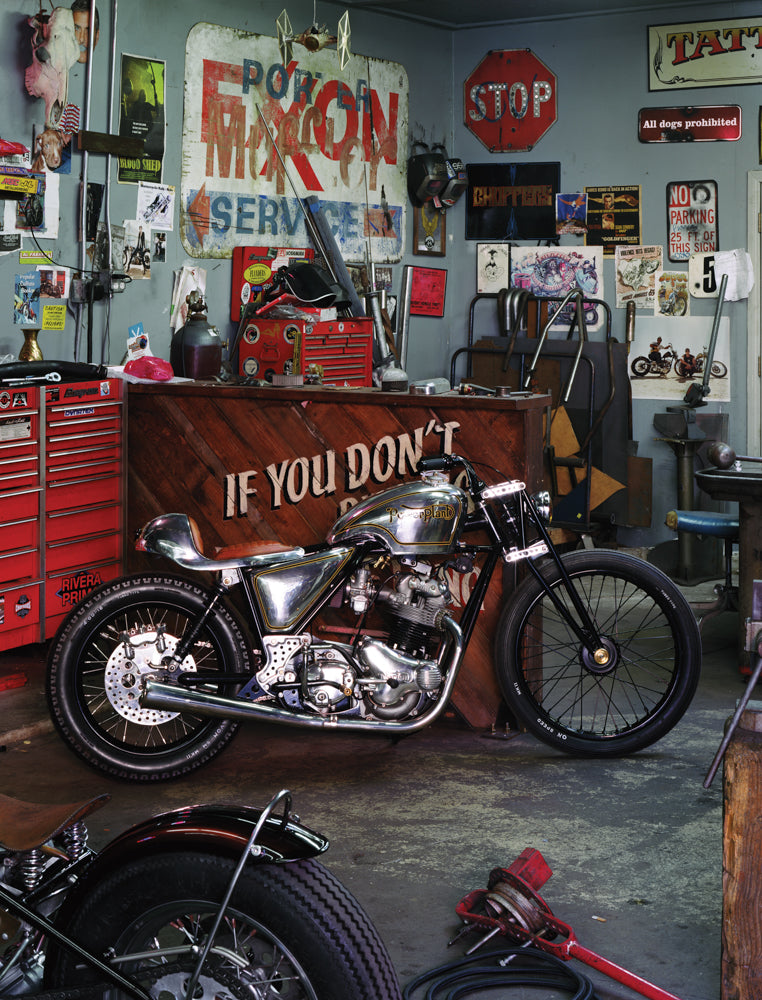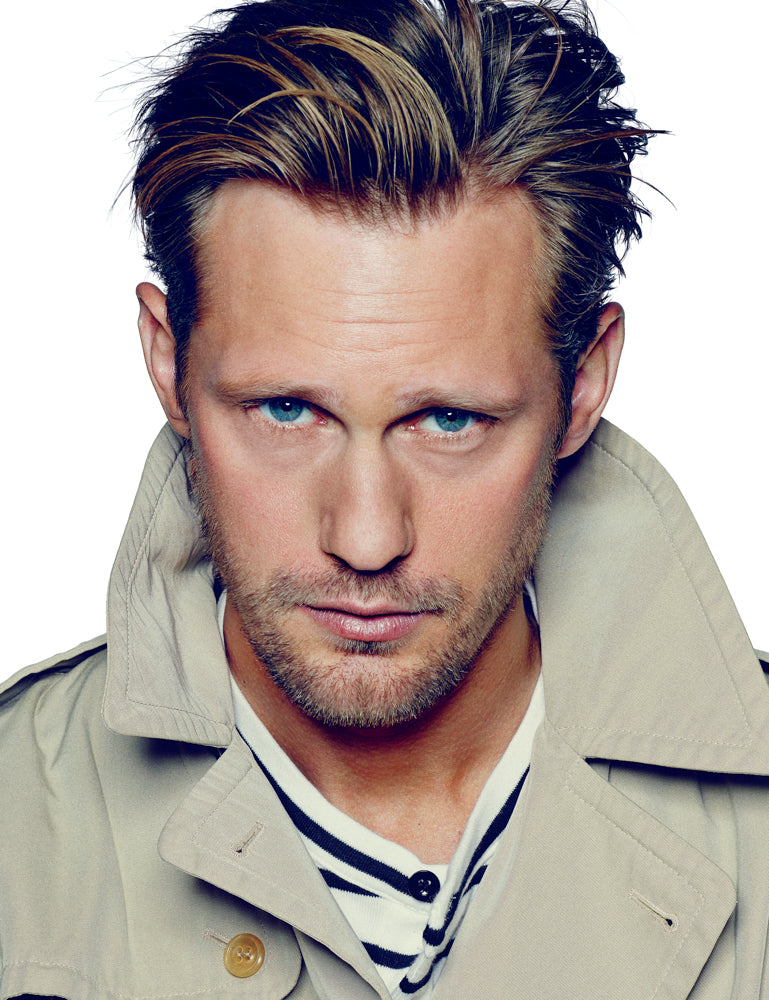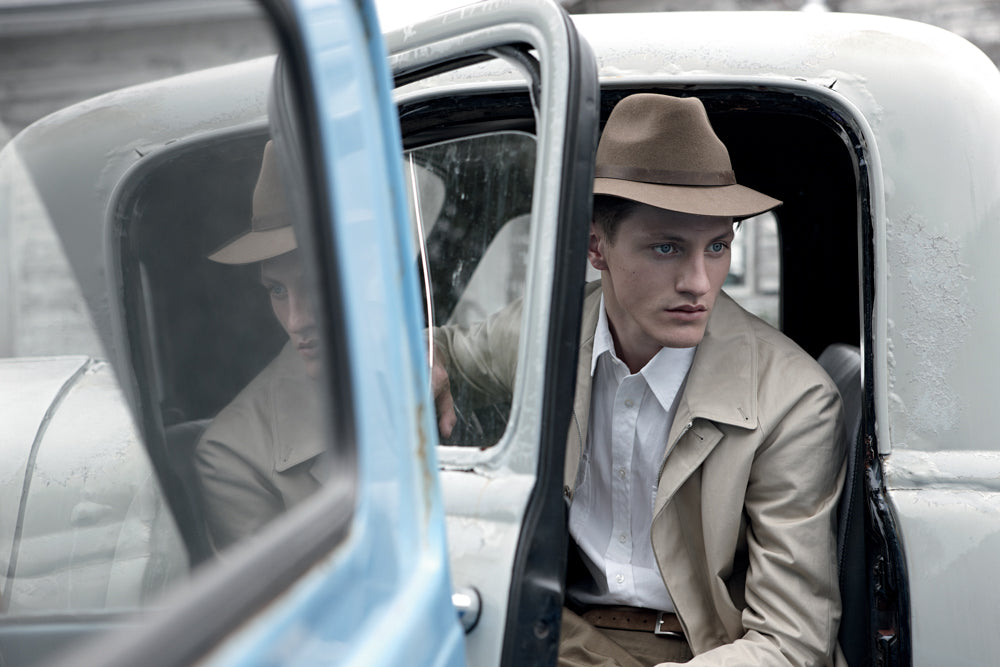
Power Plant
POWER PLANT CHOPPERS

The results must meet the fantasy of what riding a motorcycle is supposed to mean: “I am the Wild one. Hear me roar.”
The ancient lettering and wood of the sign outside of Powerplant Motorcycle Company appears to be a relic from the days when cowboys rode down Melrose Avenue. Later, you realize it’s a modern sign, weathered to look classic. The sign is an exemplar of the craftsmanship of Yaniv Evan, purveyor of Powerplant, and there were no cowboys on Melrose Avenue until Mr. Evan arrived with his posse of shop rats.
Follow the yellow line on the ground away from the frenetic street, down a hallway to the Powerplant retail shop — tooled of dark wood, brass fittings and paned glass, like an old ship. Here, you can find all the essentials of two-wheel riding: Goggles, shirts, leather, helmets, gloves and boots. Some vintage and some new, mixed together to form the new Classic, like the sign out front.


The Powerplant look is pre-Hell’s Angels, pre-Jet age, Booze-fighter-beatnik gear — it’s the tough stuff. This style was developed in Southern California when the boys came back from the Big War some seventy-odd years ago, and raced stripped-down Harley track bikes. They commiserated with other vets and drank all the beer in town.
Inevitably, your eye is drawn to the Powerplant Garage showcased behind a galley window by the register. It is clean and well lit, festooned with gas tanks, helmets and a sticker reading “Eat more flies: A biker’s work is never done.” The shop is so attractive that the likes of French Vogue and Playboy have been compelled to drape models over Yaniv’s bikes for photo shoots.

A sign painted on the pulpit in the corner of the garage reads, “Belong or don’t be long” — evidence that subtlety is a casualty when wrenching on hundred-decibel engines.
A sign painted on the pulpit in the corner of the garage reads, “Belong or don’t be long” — evidence that subtlety is a casualty when wrenching on hundred-decibel engines. Along the back wall of the shop are a drill press and lathe, machines that make more machines. Yaniv and a distinguished shop rat, sometimes called Rudy, are in the shop bending and beating metal, chopping hex stock, welding, planishing, painting. In short, they are building a fast motorcycle, from scratch.
The sight of the garage draws you outside. On any given day there are several different bikes on display: shop bikes, works in progress to be debated, facelift bikes to be rated.
Though you’ve never seen anything like it “The Hollywood Cruiser” is familiar, a composition from an old Easy Rider cartoon and the collective unconscious of cool. The gold-flake frame features an oil bag with a little nub at the top like an anarchist’s bomb — the motor is as hot and loud as an artillery barrage. It has a sissy bar, speedometer and a spring seat. The addition of suicide shifters and the removal of front brakes means that the rider is comfortable managing an overpowered machine with the skill of a horseman on a spirited mount. Nautical bits and copper fittings evoke Popeye’s steamboat. Springer shocks on the front, a single tube of steel holds the front wheel at the proper rake, exhaust pipes stick straight up in the common two-finger salute.


Mr. Evan doesn’t like more than five bikes in the shop at once and he doesn’t work for people he doesn’t like.
Well lit, festooned with gas tanks and helmets — the shop is so attractive that the likes of French Vogue and Playboy have been compelled to drape models over Yaniv’s bikes for photo shoots.
There’s a Panhead whose tank reads “Let the Bad Times Roll,” the exhaust threaded through the frame and big jap-disc brakes on the back. Or a belt driven knucklehead named “P16” whose insignia recalls the surfboards in Apocalypse Now. There is a Commando stock frame chopper and narrowed and swung-to-fit Harley hubs, racing components in the motor, with a sidecar, red and black paint scraped from hard riding, a bike that suggests the dawn of aviation.
You’ll also find the inevitable Harley club bike made familiar by Sons of Anarchy or your local biker gang; Black Harley dyna, mid-controls, ‘Frisco-style black faring and fast, fast fast.

The average civilian can’t get into the Powerplant. Powerplant differs from most chop shops just as Yaniv is not some Harley wizard tweaking up a chromed Panhead and picking grease out of his weird beard. No sir, the man is clean and wearing Vans. Further, his approach to motorcycle design borders on the good kind of compulsion. Mr. Evan doesn’t like more than five bikes in the shop at once and he doesn’t work for people he doesn’t like. Nor does he want you in his shop, dicking around when he is working.
Yaniv takes seamless quarter DOM steel (drilled not rolled), and bends it to shape the frames so it sits just right for the customer. He shapes the bike around the frame in cardboard for the trial and error part of getting it right. Yaniv likes to “take the stock and make it flow,” spending the necessary hours to hide the cables until it has that certain “nothing.” Then he hammers the stainless of the gas tank for a month til it’s smooth and mounts it on rubber so the beast doesn’t rattle itself apart. Yaniv is Powerplant’s aftermarket source, fabricating every peg, every gas cap, the switches, air cleaners, handlebars, knobs, bolt ends — even the leather seat is stitched by the man himself.


Knuckleheads, Nortons, Triumphs, the nontraditional Evo motor: Powerplant Choppers doesn’t need no stinking allegiances.
The engines, or powerplants, of these bikes are the tried and true heavy hitters. The Panheads, knuckle- heads, Nortons, Triumphs, or even the nontraditional Evo motor. Powerplant Choppers doesn’t need no stinking allegiances. Yaniv follows no strict dogma. It’s about what the Rider wants, long as the Rider wants it to be badass and go a half mile in eight seconds. The results must meet the fantasy of what riding a motorcycle is supposed to mean: “I am the Wild one. Hear me roar.”
Powerplant bikes demand attention, a natural asset in a city like Los Angeles. Mode of transport is another face by which a man is recognized. To deny that what you ride is part of your identity is to refute that you carry a card called a drivers license, with your picture on it, for cops and bouncers to look at when they ask who you are.
Yaniv has been on Melrose ten years, watching the fads fade until an appreciation for artisanal work returned. I saw it. It’s happening. Thirty feet off the pop hubbub of Melrose Avenue, on the other side of a riot gate, past a tough bastard named Dallas and a cranky pit bull, a guy named Yaniv Evans is literally manufacturing the look in the Powerplant Garage and putting it on the street. Right now.





